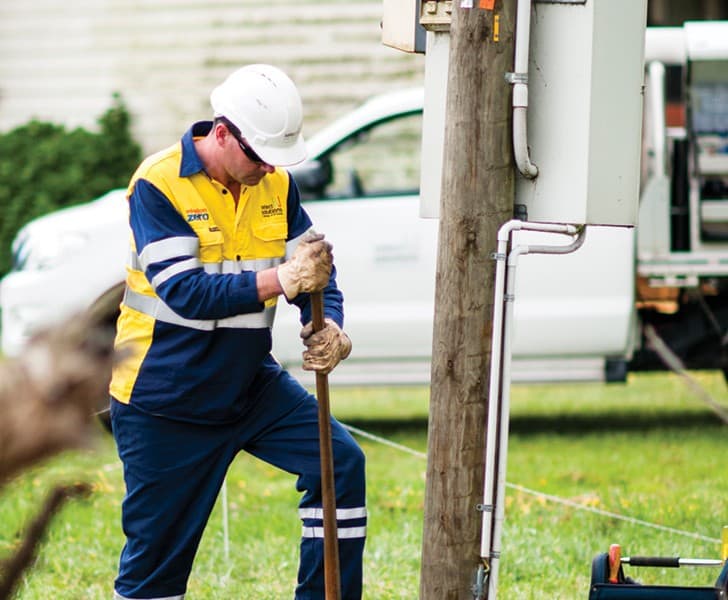by Natalie Hunter, Secretary, NULCA Australia
While utility locating is certainly not a new industry, many misconceptions remain about what can be achieved with the tools in a locator’s toolbox.
The term ‘pipe and cable locating’ is a bit of a misconception for starters.
An electromagnetic field (EMF) locator does not locate pipe and cables. It detects an electromagnetic field as it transitions along a metallic pipe or cable. The electromagnetic field is then located by the receiver.
Locators will know that other contractors on site will think that with a wave of an EMF receiver, any assets will be magically located. The reality is, there are limitations for EMF locators, just as there are for ground penetrating radar (GPR) locators.
By now, most people are aware that service locating devices exist, but there is still limited knowledge on construction sites as to what equipment or method is required to locate specific types of pipe material.
EMF is the essential tool in a locator’s truck. It works in a more diverse range of ground conditions; it has the ability to trace target lines and is generally easier and faster to learn the basic principles of use, and when and how it can be used. The drawback is that it relies on the service being metallic, having undamaged metallic trace wires or the service needs to be accessible to insert a traceable rod to locate. It does not locate direct buried optic fibre or non-metallic pipes such as PVC or nylon without having a trace wire.
GPR is used for mapping or locating non-metallic pipes and underground storage tanks. GPR transmits a small electromagnetic wave through an antenna and then a pipe or cable reflects energy back to the ground surface and received by the antenna. The depth and resolution of the target is related to antenna frequency, power transmitter and the dielectric of the ground. In layman’s terms – GPR’s effectiveness is highly reliant on ground conditions due to the electrical conductivity of the ground or water and clay content.
However there still remains a belief that a service locator’s GPR can show a perfect skeleton buried in a grave. The reality is that GPR does not show a perfectly formed pipe on the screen – in a good scan it will show a hyperbola. They cannot tell you the size or material of a pipe or cable or what service is within that pipe. The only thing to do is pothole to verify and record what you find. GPR is an excellent tool to be used in conjunction with EMF.
On-site locations
Quite often on site you’ll hear complaints along the line of “The previous locator didn’t locate all the services so we are trying someone else”. It’s obvious that no locator would go to site and intentionally miss locating a service; but there are things locators and clients can do to minimise missed services.
Have all plans of the site available for the locator. Dial Before You Dig (DBYD) is the essential first step for acquiring plans, even when working on private property. These need to be up to date for each asset and printed to a legible size or viewed on iPad or larger screen. Sight the DBYD referral/job number sheet to confirm all the plans from each asset owner are there. Remember that asset owner plans are indicative only – in the real world the cable or pipe indicated on the plan may actually be on the opposite side of the road. You may also need to get plans of water and sewer assets from councils who are not members of DBYD. If you are working on private property – are they able to supply any as-built plans or sketches of services for the site from previous works? All of these are going to help the locator identify services and improve efficiency on the job. It is much quicker and more thorough than just doing a blind scan of your site.
Consider whether asset owners will locate their own services. This varies state to state but Telstra has an accredited plant locator system which authorises contractors to access and locate their network. Not all contractors are authorised to locate the optic fibre, they may just be copper accredited. Other communication asset owners and high pressure gas pipes may require their own staff to locate the service, and you will need to check each asset owner’s duty of care to confirm this. This may also be an additional cost.
Consider any visible features indicating there is a service in the area. Quite often as a locator you encounter the issue of marker posts being removed from the original position because they were knocked over or deliberately removed by a third party, making it extremely difficult to locate optic fibre that may be direct buried, have no trace wire, no transponder or have large distances between pits. If there are no plans to indicate a service in the area and no visible features, it is quite easy to not locate a service upon electronic inspection (both EMF and GPR). The probability of a missed service is higher if the service is non-metallic.
Understand how to use tracer wires. Comments such as “It is laid with a trace wire so you should be able to locate it” are commonly heard on site. For a trace wire to be located effectively, the locator should directly connect to the wire. Hopefully the trace wire has been brought to the ground surface, such as at a meter, valve box or into a pit. A trace wire not accessible for connection may result in the inability to locate a target line, especially in a service-congested area or if laid at a substantial depth. When using EMF induction method at ground level in a service-congested area such as a footpath, there is a good chance the target line won’t be located because the signal will be mutually inducted onto other targets such as metallic water pipes, electrical and copper communications cables, Armco railings and temporary fencing. This can also happen when connected to the trace wire, and it is vital for the locator to check their current measurements.
Search outside the specified zone. Another complaint from site is “What are they doing locating over there, I only want this section searched”. The locator may need to connect to a service feature (tap, meter, pit) outside of the search area to trace it running through the specified area, or verify that it does not enter the work zone. Sometimes with GPR, a locator may need to follow the line from a hydrant to ensure they are tracing the desired target within the work zone. Regularly with GPR, it might not be possible to locate the service within the work zone, but it can be seen on either side of it – thus helping to determine an appropriate area to pothole to verify the position of the service.
Understand AS5488-2013. The utility locating standard states that if Quality Level B information is compiled using electronic detection, it is only an indication of the existence of subsurface utilities and does not validate the utility subsurface location or attributes. A Quality Level B location has to be within + or – 300mm horizontally (relative spatial position) and within + or – 500mm vertically (relative spatial position) of the service. There is quite a bit of room as a tolerance from actual depth of the service. During construction, when the services are actually located and potholed, it may be found that the design may not be possible due to lack of clearance. Many additional construction costs can be avoided with locating, potholing and surveying at a design phase. If an approximate is good enough for the job then engage a locator, but if precision and service location is required, then pothole services and the services surveyed.
Quality assurance. The only way to prove the accuracy of a service location is to pothole and verify position and depth. As stated above there is a fair range of tolerance from where the service location mark is at ground level compared to where the actual service may be.
There is certainly more that can be considered – but in short, clients and locating contractors need to work together to minimise the risk of service damage. More information can be obtained through the National Utility Locating Contractors Association. Visit www.nulca.com.au.















